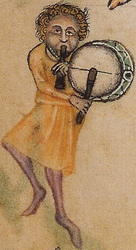Tabor (instrument)
 Pipe and tabor player, c. 1325–1335 | |
| Classification | Unpitched percussion instrument |
|---|---|
| Related instruments | |
A tabor, tabour, tabret (Welsh: Tabwrdd), tambour de Provence, Provençal tambourin or Catalan tamborí is a portable snare drum, typically played either with one hand or with two drumsticks. The word "tabor" (formerly sometimes spelt "taber") is an English variant of the Persian word tabīr, meaning "drum"[1][2]—cf. Catalan: tambor, French: tambour, Italian: tamburo[3] Militaries may use the tabor as a
Construction

A tabor has a cylindrical wood shell, two skin heads tightened by rope tension, a leather strap, and an adjustable snare. The single snare can be made from gut, silk, or rough hemp.
Usage
The tabor is most widely known as accompaniment for the pipe and other small flutes, such as the flageolet,[4] and most famously as the percussive element in the "pipe and tabor" one-man band configuration.[3] The tabor is beaten on the snare side.
Georges Bizet scored for the tabor drum in his L'Arlesienne Suite No. 2, and Aaron Copland calls for it in his Appalachian Spring and El Salón México. Darius Milhaud has been named one of the foremost composers of modern (mid-20th century) music for the tabor by Morris Goldenberg. His Suite Provancale calls for tabor played along with two other drums by a single player. In classical repertoire the tabor is usually played with two sticks, as many pieces call for speeds that are unwieldy for a single hand. In many cases composers' scores have been mistranslated with the erroneous call for tambour de basque or tambourine when the piece was originally intended for tabor. Parts written for tabor are usually very simple and feature straight eight notes or another easy repetitive pattern.[4]
History

The tabor is classified as a membranophone and dates back to the Medieval period in Europe.[5] Hand-written documents and engravings are some of the earliest recordings of this instrument.[5][6] The size of these early tabors ranged approximately 11-12 inches in diameter and 4-10 inches in width/depth.[5][6] These 13th century tabors were thus larger across their diameter, but the tabor continued to evolve with time and eventually some were almost even in diameter and width.[6] The 16th century design of the tabor changed to the opposite proportions from the earlier models with the width being greater.[6]
Tabors were constructed of wood for the body of the drum with the stretched membrane made out of some type of skin.
The common way of playing the tabor together with the pipe produced the effect of a single person band.[8][9] It was often played for dancing, and was sometimes played as a small ensemble with the bagpipes.[5][7] Since the tabor was used to accompany dancing, regular rhythmic beats were common for this instrument.[6] The tabor was used to accompany Morris style folk dancing.[6]
Initial documents show that a type of horn was played with the tabor, which then later lead into the
See also
References
- ^ "Tabor". Merriam-Webster.com Dictionary. Retrieved 2024-04-05.
- ^ "tabor (n.)". www.etymonline.com. Retrieved 2024-04-05.
- ^ a b c Harms Historical Percussion's Tabor page.
- ^ a b c d Goldenberg, Morris. Modern School for Snare Drum with a Guide for the Artist Percussionist. USA: Chappell and Co., 1955.
- ^ a b c d e f g h i j "Tabor". Grinnell College Musical Instrument Collection. Retrieved 2018-11-01.
- ^ JSTOR 20753663.
- ^ OCLC 50169470.
- ^ OCLC 7513990.
- ^ JSTOR 20753664.
- ^ Beck, John H. Encyclopedia of Percussion. Routledge, 2013.
External links
- Musicien jouant du flûtet-tabor, illustration, details (in French)
